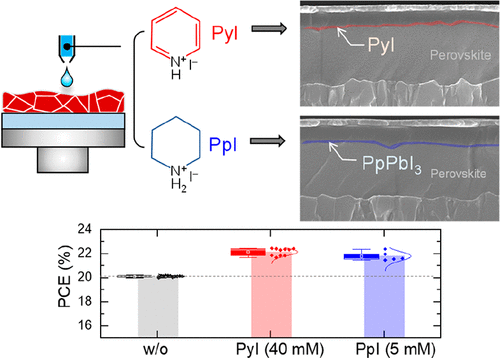当前位置:
X-MOL 学术
›
ACS Energy Lett.
›
论文详情
Our official English website, www.x-mol.net, welcomes your
feedback! (Note: you will need to create a separate account there.)
Effect of Chemical Bonding Nature of Post-Treatment Materials on Photovoltaic Performance of Perovskite Solar Cells
ACS Energy Letters ( IF 19.3 ) Pub Date : 2021-09-07 , DOI: 10.1021/acsenergylett.1c01376 Jeong-Hyeon Kim 1 , Seul-Gi Kim 1 , Nam-Gyu Park 1
ACS Energy Letters ( IF 19.3 ) Pub Date : 2021-09-07 , DOI: 10.1021/acsenergylett.1c01376 Jeong-Hyeon Kim 1 , Seul-Gi Kim 1 , Nam-Gyu Park 1
Affiliation

|
We report here on the effect of chemical bonding nature of post-treatment materials on photovoltaic performance in perovskite solar cells using pyridinium iodide (PyI) with delocalized π electrons and piperidinium iodide (PpI) without a π bond. A gradual increase in power conversion efficiency (PCE) from 20.13% to 22.26% is observed as the PyI concentration increases from 0 to 40 mM, while PCE is optimized at relatively low concentration of 5 mM for PpI. It is found that a PyI layer is formed at the perovskite/HTL interface by the PyI treatment, which is beneficial for hole extraction even at increased interlayer thickness. On the other hand, an insulating 1-D PpPbI3 formed by PpI treatment blocks charge separation, which is pronounced at high concentration. Our comprehensive comparative work on post-treatment materials delivers a message that different thicknesses for each material are required to achieve decent photovoltaic parameters.
中文翻译:

后处理材料的化学键合性质对钙钛矿太阳能电池光伏性能的影响
我们在此报告了使用具有离域 π 电子的碘化吡啶 (PyI) 和没有 π 键的碘化哌啶 (PpI) 的后处理材料的化学键合性质对钙钛矿太阳能电池光伏性能的影响。随着 PyI 浓度从 0 增加到 40 mM,观察到功率转换效率 (PCE) 从 20.13% 到 22.26% 逐渐增加,而 PCE 在 5 mM 的 PpI 浓度相对较低时进行了优化。发现通过 PyI 处理在钙钛矿/HTL 界面处形成 PyI 层,即使在增加层间厚度的情况下,这也有利于空穴提取。另一方面,绝缘的 1-D PpPbI 3PpI 处理形成阻止电荷分离,这在高浓度下很明显。我们对后处理材料的综合比较工作传达了一个信息,即每种材料需要不同的厚度才能实现合适的光伏参数。
更新日期:2021-10-08
中文翻译:

后处理材料的化学键合性质对钙钛矿太阳能电池光伏性能的影响
我们在此报告了使用具有离域 π 电子的碘化吡啶 (PyI) 和没有 π 键的碘化哌啶 (PpI) 的后处理材料的化学键合性质对钙钛矿太阳能电池光伏性能的影响。随着 PyI 浓度从 0 增加到 40 mM,观察到功率转换效率 (PCE) 从 20.13% 到 22.26% 逐渐增加,而 PCE 在 5 mM 的 PpI 浓度相对较低时进行了优化。发现通过 PyI 处理在钙钛矿/HTL 界面处形成 PyI 层,即使在增加层间厚度的情况下,这也有利于空穴提取。另一方面,绝缘的 1-D PpPbI 3PpI 处理形成阻止电荷分离,这在高浓度下很明显。我们对后处理材料的综合比较工作传达了一个信息,即每种材料需要不同的厚度才能实现合适的光伏参数。











































 京公网安备 11010802027423号
京公网安备 11010802027423号